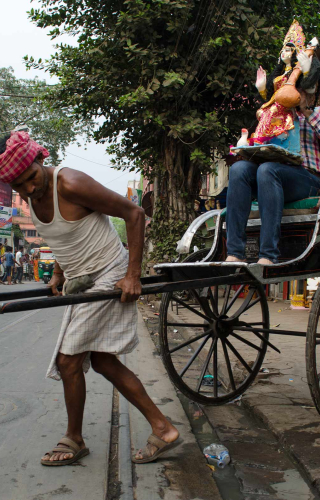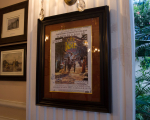Kolkata is a city of contradictions. The first city in India to construct a metro rail, it is now the only city in the world that continues to operate licensed hand-pulled rickshaws (called tana rickshaw in Bengali) as a mode of public transport. According to All Bengal Rickshaw Union, it is estimated that more than 14,000 unlicensed and more than 5,000 licensed rickshaws are currently operational in Kolkata.
The word ‘rickshaw’ originates from the Japanese word ‘Jin-riki-sha’ (jin meaning human, riki meaning power, and sha meaning vehicle; which translates to human-powered vehicle). However, in India, human-powered vehicles had existed earlier, in the form of the palki (palanquin). Unlike the rickshaw, the palki was a covered litter and was carried on shoulders by four bearers. In the past, when India had few paved roads, the palki was an efficient means of personal transport, because they were without wheels. British Calcutta had a large migrant population of Biharis and Odiyas who served as palki bearers in the eighteenth and nineteenth centuries. These palki bearers were, in a way, the forerunners of today’s rickshaw pullers. The popularity of palkis declined with the arrival of horse-drawn buggies, bicycles, hand-pulled rickshaws, trams, railways and other forms of mechanised public transport.
The hand-pulled rickshaw was invented in Japan in 1869 and was introduced in China by 1874. Unlike previous modes of transport, like kago, sedan chairs, etc. which needed two persons to carry, the rickshaw had the significant advantage of being driven by a single person. The following decades witnessed a boom of hand-pulled rickshaws in Japan, China, Singapore, India, Indonesia and Malaysia. They served as cheap means of transportation and provided employment to millions of poor working-class families living in cities.
Calcutta’s preeminent position as the capital of British India played a critical role in the development of public transportation in the city. The East India Company was deeply involved in facilitating the opium trade with China, and Calcutta already had a significant Chinese population, who arrived in Calcutta throughout the nineteenth and first half of the twentieth century, fleeing devastating famines and displacement due to political upheavals in China. These new immigrants arrived from British colonies like Canton, Shanghai and Hong Kong, and they introduced the rickshaw to Calcutta. The hand-pulled rickshaw had already been introduced a couple of decades earlier in Shimla, which served as the summer capital of the British Raj, though in Shimla its use remained limited due to the hilly terrain. In 1919, the Hackney Carriage Act was passed by the British allowing hand-pulled rickshaws to be hired as a passenger transport vehicle in Calcutta.
The British were the dominant colonial power in Asia and the usage of a human to pull another human definitely served in reinforcing the master-slave power hierarchy. Post World War II, colonialism declined in Asia and the hand-pulled rickshaw faded out of use from erstwhile British colonies. Strangely, the legacy of rickshaws continued in Calcutta long after the British Empire was gone (1947), and long after the communist government in China banned (1949) the use of rickshaws. Not only did it survive in Calcutta but the tenacious hand-pulled rickshaw has become an icon of the metropolis.
I have always been fascinated by hand-pulled rickshaws, and have been photographing them for almost a decade now. During the course of my research, I went on to interview some rickshaw pullers and commuters in Kolkata to gain insight into the present conditions of the people involved in the profession, and how the rickshaw survived the onslaught of time and technology.
I tracked down workshops, only a few of which now remain operational. The workshops mainly repair old rickshaws or dismantle parts to be reused in making new models. It was there that I realised that every part of a hand-pulled rickshaw is made by hand, and the craftsmen work in very crude conditions.
The biggest challenge, however, was convincing the rickshaw pullers for an interview. A good number of them refused to talk. Similarly, I was denied entry to a khatal in north Kolkata as well as a workshop in central Kolkata. Their reticence is understandable as they have always been treated like a nuisance by the civic authorities, which has made them suspicious of outsiders enquiring about them.
The hand-pulled rickshaw survives due to a number of socio-economic reasons peculiar to Kolkata. Firstly, pulling a rickshaw does not require skill; it requires hard physical labour. Unemployed and unskilled labourers find employment as rickshaw pullers in Kolkata. They do not undergo any training or require a driver’s license to operate. Most rickshaw pullers do not even know the names of the roads they ply their trade on, nor do they understand the various traffic symbols. This is because they are mostly illiterate and speak Hindi instead of the local Bengali. Many rickshaw pullers do not even own the vehicles themselves, but rent them from sardars (rickshaw owners) who own khatals (rickshaw garages). This arrangement evolved because many rickshaw pullers are either too poor or seasonal migrants, plying the rickshaws only for a few months when their fields back home lie fallow.
Secondly, urban planning has also played a part in the continuance of this mode of transportation. Due to poor drainage, streets in low-lying areas get flooded frequently. During heavy monsoons, the hand-pulled rickshaw is the only form of transport which can navigate flooded streets. Its non-reliance on fossil fuels makes it less expensive and non-polluting, and its compact size allows easy navigation through the narrow lanes of Kolkata.
Today, due to declining popularity and availability of other modes of transport, rickshaw pullers earn a meagre amount and mostly live on the streets, saving every rupee to send to their families. Added to this are costs for food and rent paid to sardars, after which they are left with very little money for themselves. Many turn to alcohol and suffer from various diseases and medical problems associated with old age and the physical stress of the job.
Kolkata has faced much flak due to the existence of this colonial relic. In 2006, the state government tried permanently banning these rickshaws by the passing of the Calcutta Hackney-Carriage (Amendment) Bill, but it was never implemented. Nothing has changed after the change of government in 2011, though promises were made about replacing the licensed hand-pulled rickshaws with electric or cycle rickshaws. If these rickshaws need to be permanently removed from the streets, a justifiable solution needs to be worked out to ensure proper rehabilitation for all the people directly and indirectly attached to the trade.
















